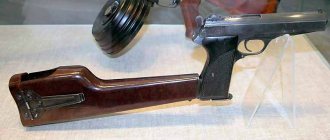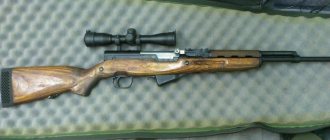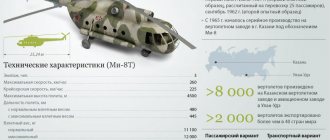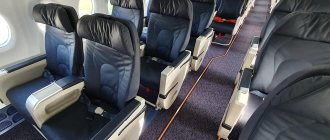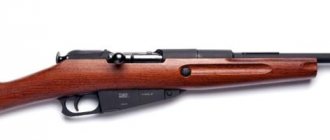A little history
They tried to create a multi-charge grenade launcher with manual reloading during the Vietnam campaign. In 1968, these efforts led to the China Lake model. This literally translates as “Chinese lake,” but the weapon had nothing to do with China—it’s just the name of a US Navy research center.
"China Lake"
In fact, it was a large pump-action shotgun of a completely classical design, except that now it could fire not 12-gauge cartridges, but full-fledged 40-mm grenades. This is not the M203 grenade launcher or the “breakthrough” M79 with their poor rate of fire: the new grenade launcher could release all its ammunition in five seconds, showering the enemy with a swarm of deadly fragments! True, the machine turned out to be large, and they made only a few of them. But “China Lake” is quite suitable for the role of a fighter for our battle.
In the distant, snow-covered USSR, they did not learn about such a twist of the American weapons genius soon - only by the beginning of the 90s. But at the Tula KBP (Instrument Engineering Design Bureau) the idea came to fruition. In addition, they had their own gun, which for some reason could not find a buyer. He, too, was properly fed, called GM-94 and, as usual, offered to the Ministry of Internal Affairs.
And what do you think? It's a blast!
GM-94
Let's take a look - which of the opponents will emerge victorious in the fight?
Foreign analogues
Alas, such weapons are in demand both here and abroad. The most popular type of ammunition in NATO countries is 40 x 46 mm. In particular, they are used by American M79 grenade launchers, which were used in the Vietnam War and a newer version - CIS 40GL. Both fire one grenade at a time with further reloading. The GM-94 is superior to its US counterpart in terms of weight and technical performance. South Africa has a good development - MGL Mark1, a revolver-type grenade launcher. The Tula GM-94 has the best accuracy in shooting, which is a safe factor for its forces, allowing it to conduct combat operations at short distances.
Production volumes
Before assessing this criterion, we must remember that both models are narrowly targeted products intended for special units. They will never catch up in popularity with, for example, under-barrel grenade launchers. However, the domestic model is a clear winner: even though TsKIB stubbornly remains silent about the total number of weapons produced, the GM-94 has long ceased to be a curiosity in the units of the Ministry of Internal Affairs - it is in almost any regional special forces or riot police.
Moreover, under the name LPO-97 (light infantry flamethrower), it has been adopted by the Russian army since 2007 (although they use different ammunition). LPO-97 is supplied to the armed forces in small quantities.
Early version of LPO-97
Why "flamethrower"? Its main ammunition is a thermobaric grenade. RPO (rocket-propelled flamethrower) "Bumblebee" is also officially called a flamethrower.
In general, the production of GM-94 in different versions amounts to many hundreds, or even thousands.
With China Lake the situation is not at all so rosy.
Despite the solid PR, in reality the total number of grenade launchers produced was, according to various estimates, from 12 to 30 pieces.
Only. True, in 1992, a team of enthusiasts began working on improving the model, and a private company announced in 2005 that the modernized version was ready for release and was being offered to the American army.
Sketch…
...and a prototype of the modernized China Lake grenade launcher
In the updated version, problems with feeding grenades with a flat top part were eliminated, the magazine capacity was increased (up to 4+1), and Picatinny rails were installed on the barrel and receiver, allowing the installation of modern collimator sights and other equipment. A telescopic stock and a pistol grip from the M4 carbine also appeared.
Alas, the military was not tempted by such tempting conditions. Still, many perceive the pump-action circuit as a relic of the past. The army relied on the Milkor M32 revolver.
Sales on the private market also did not work out - although the United States is considered by many to be a “gun paradise,” it is far from easy for a private individual to buy a real “border gun” there.
Total:
"China Lake" - 1 point GM-94 - 4 points
Purpose
Grenade launchers, due to their compactness and low weight, are becoming a popular weapon in modern warfare. The effect and efficiency of its shooting is akin to the work of an artillery installation. These weapons are used by army units in armed conflict zones, police units when maintaining law and order, and special forces during various operations. The GM-94 hand grenade launcher is used during close combat in the city, supporting infantry units with fire, in mountainous areas, on slopes, in confined spaces, in various types of buildings. A grenade launcher device is used to destroy light armored equipment and vehicles, enemy personnel, create a camouflage effect with the help of smoke screens, fires, thereby preventing the enemy from conducting targeted fire to kill.
The compact and lightweight complex, even under intense shooting conditions, does not betray the shooter, thanks to its high camouflage characteristics. The fire flash is almost invisible, and the sound of the shot is barely audible.
Ammunition prevalence
There is no point in listing all the types of grenades created for our and imported samples. I’ll say right away: Americans have a much wider range of products. The overseas ammunition based on the 40×46 mm cartridge case is universal: it is suitable for automatic, under-barrel, and revolver grenade launchers, and for single-shot “breakers”. This is NATO’s standard ammunition; it is produced by many member countries of this military bloc (and not only them). From a logistics point of view, this is very convenient.
40x46 mm grenades produced by Singapore
The domestic grenade traces its origins from an active-missile projectile to the experimental TKB-700 air gun of 45 mm caliber. They wanted to put it on the Su-25T attack aircraft, but it never made it into mass production (as, indeed, the aircraft itself).
However, the line for the production of shells has already been established.
The zealous Tula residents decided - why waste the goodness?
On the basis of a plastic casing, they built the VGM-93 ammunition, which is completely atypical for the Soviet/Russian military industry, suitable for one single type of weapon.
VGM-93
At the moment, the range of shots for the GM-94 is small: thermobaric, training, irritant, smoke, light-noise and shock-shock (non-lethal) action. So, according to this parameter, the domestic model is a clear loser.
True, the thermobaric ammunition turned out to be very good - and, according to some sources, it flies as much as half a kilometer. The Americans stated the target range was 300 meters. But…
Total:
"China Lake" - 5 points GM-94 - 3 points
Characteristics
The GM-94 is not much heavier than a conventional machine gun. Its weight is 4.5 kg. The length of the weapon with the shoulder rest folded is 540 mm. For ease of firing, the shooter can easily expand the butt, which will increase stability and, consequently, accuracy, which is especially important in close combat.
Not only right-handers were able to appreciate the advantages of this weapon. The grenade launcher is designed so that even a left-handed person can fire.
Sighting range – 300 m, maximum operating efficiency – 600 m.
The magazine holds 3 grenades. The weight of the loaded weapon depends on the type of ammunition used.
Ease of handling
The folding stock of the GM-94 makes it possible to significantly reduce the dimensions of the weapon during transportation, and the characteristic shape of the stock makes it easier to aim if the shooter is wearing a heavy helmet, such as the “Mask” used in various units of the Ministry of Internal Affairs.
The length of the aiming line on the GM-94 is longer than that of its opponent, hence theoretically the shooting accuracy is higher. The pistol grip and the location of the safety, in my opinion, make the domestic model more ergonomic, and the pronounced protrusions on the fore-end help to hold the weapon and reload it. The self-cocking firing mechanism (the force on it is six kilograms), according to the manufacturer, increases safety when carrying a weapon in a combat position - with a grenade in the barrel.
On the other hand, the China Lake has a slightly higher loading speed - be sure to stuff grenades into the under-barrel magazine; and when completely unloaded, the first grenade can be thrown directly into the barrel.
This trick will not work with the GM-94. To put it into combat mode, you must first unfold the butt, then open the magazine lid, and only then put grenades in there one at a time.
GM-94 - with the magazine cover folded down and the barrel moved for reloading
Reloading a weapon by moving the forend with the American is more natural, more ergonomic - you pull the forend towards you, then back. The Tula product, where everything is the other way around, puts you into a stupor out of habit.
In general, both samples have their pros and cons. Taken together, they can be considered equivalent in terms of convenience - albeit with some stretch.
Total:
"China Lake" - 4 points GM-94 - 4 points
GM-94 hand grenade launcher system
During armed conflicts, during law enforcement and peacekeeping activities, actions with the use of weapons most often take place in a limited space of populated areas, in individual buildings and structures of residential, commercial and administrative buildings, with a large concentration of manpower.
An analysis of the most common tactical and fire tasks shows that there is no universal weapon for solving them.
For many decades, grenade launcher systems have been the leading armament of various units called upon to operate in local conflicts and in special operations, since with rather modest weight and size characteristics they are comparable in power and efficiency to artillery systems.
Rocket-propelled grenade launchers and flamethrowers, characterized by the great power of their combat equipment, but also by a significant dangerous zone created behind them by powder gases and separated fragments, can be used in built-up conditions only from open positions, and in a limited space they are dangerous for the shooter. In addition, they are quite vulnerable, as they unmask the firing position with a strong sound, flash and smoke from the shot.
Standard under-barrel and hand grenade launchers use VOG-25, VOG-25P rounds with a fragmentation grenade, the damaging effect of which is noticeably reduced in built-up areas.
An analysis of the use of standard grenade launchers shows that in order to increase the effectiveness of countering mass riots, illegal actions and terrorism, and fighting in the city, a weapon system that meets the following requirements is necessary:
• minimum firing range safe for a grenade launcher;
• minimal unmasking signs (sound, flash of flame);
• the possibility of firing in a confined space (buildings, structures, vehicles);
• high maneuverability (easy to carry, low weight and dimensions);
• high rate of fire;
• high selectivity (accuracy and accuracy) of shooting.
The listed requirements are met by the GM-94 hand-held grenade launcher complex developed by the Instrument Design Bureau (SUE KBP), consisting of a 43-mm magazine grenade launcher and VGM rounds.
The grenade launcher is intended for:
• creating intolerable conditions for manpower in open areas and indoors;
• damage to manpower in urban areas, in basements, fortifications, terrain folds, mountains and vehicles;
• blinding crews of fire weapons, creating smoke screens, fires on the ground, in buildings, structures and warehouses of fuels and lubricants;
• disabling automobile and lightly armored vehicles.
A grenade launcher with minimal unmasking signs (minor sound of a shot, no flash of flame) allows firing in open areas, from confined spaces and vehicles, and there is no thermal effect on the shooter.
The GM-94 is made according to the pump-action design of the 12-gauge "Lynx" shotgun, developed by the State Unitary Enterprise "KBP" in 1993. “Lynx” is reliable in operation and has been in mass production since 1995.
Reloading is carried out using the shooter's muscular strength by moving the fore-end with the barrel forward, which made it possible to abandon the sliding bolt and reduce the dimensions and weight, the number of parts and assembly units. The barrel is locked by a mirror of the receiver and side lugs. The barrel under the tubular magazine increases the stability of the grenade launcher when firing. Loading is done from above, which makes it easy to reload the magazine. The spent cartridge case is reflected downwards, which is important when using a grenade launcher in rooms and vehicles, as well as when shooting left-handed.
The self-cocking trigger mechanism made it possible to create a weapon that is constantly in combat readiness. Cocking the mainspring of such a mechanism only by pressing a finger on the trigger ensures safe carrying of a grenade launcher with a shot in the chamber. It is easy to use and reliable in operation, equally convenient for both right-handers and left-handers.
The weapon allows you to fire with a folded shoulder rest, which also serves as a carrying handle. The transfer time from traveling to combat position is 1-2 seconds. To fire from the GM-94 grenade launcher, the following types of 43-mm VGM-93 grenades are used:
• irritating action of the “smoking” type;
• shock-shock action with an elastic striking element;
• with thermobaric equipment.
The ability to use various types of grenades increases the combat qualities of the grenade launcher and ensures its effective multi-purpose use.
A thermobaric grenade affects enemy personnel with varying degrees of severity within a radius of 3 m from the detonation site, lightly armored vehicles with armor thickness up to 8 mm, and is effective against a wooden door (40 mm thick, covered with 2 mm steel sheet) and a brick wall (half a brick thick ) due to excess pressure. The grenade is shatterproof. The minimum safe operating distance is 5 m.
Main technical characteristics of a shot with thermobaric equipment
| Initial speed of the grenade, m/s | not less than 85 |
| Weight, kg: | |
| - shot | 0,31 |
| - grenades | 0,25 |
| - combat equipment, g | 160 |
| Fuse | safety type |
An irritant grenade allows you to create intolerable conditions for manpower in an open area of at least 100 square miles in rooms with a volume of at least 300 cubic meters.
A shock grenade with an elastic striking element is designed for reliable physical neutralization of offenders with minimal damage to their health.
If the appearance of such a development as the GM-94 is dictated by the conditions of modern combat and the crime situation, then it is quite natural to assume that models of a similar purpose have been created and are being created in other countries. Information about new experimental developments of hand grenade launchers is constantly being received, which serves as further evidence of the need and demand for such weapons. But it is constantly changing and is insufficient for comparative analysis. Serial models in service are also known.
In the armed forces and police of many countries around the world, single-shot hand grenade launchers with a 40x46 mm shot are common. This type of ammunition is quite common, mainly in NATO countries, and is produced with grenades of various equipment, both for military use and for the police. One of these samples is a rather old American model M79, which was used in the Vietnam War; the CIS 40GL grenade launcher is a more modern development, but their combat capabilities are almost the same. The design of these models is very simple and resembles the well-known flare gun. These samples are inferior to the GM-94 grenade launcher in all combat and operational characteristics. Even the advantage in weight is imaginary, since this is the weight with one shot, for the GM-94 it is 1.2 kg, which is almost 2 times less than that of the CIS 40GL, not to mention the M79.
The closest analogue of the GM-94 grenade launcher in terms of purpose and scope of application is the MGL Mark1 revolver grenade launcher, developed in South Africa. The same 40 mm rounds are used for firing as in single-shot models. If we compare the combat power of these ammunition and shots for a Russian grenade launcher, then it will be enough to note that the mass of the thermobaric explosive charge of a VGM shot is more than 3 times higher than the charge of a conventional 40x46 mm shot. To the same extent, this proportion is true for other types of shots (with irritant, smoke, etc.).
The fundamental difference between thermobaric non-fragmentation rounds for the GM-94 and high-explosive 40-mm ammunition is a clearly localized affected area, which makes it possible to minimize the danger to one’s own personnel and the civilian population when fighting in the city. This feature makes it possible to reduce the range of use of the GM-94 several times in comparison with analogues, the use of which inside buildings is almost impossible.
To reload MGL Mark1 revolvers, the energy of powder gases is used, which, if it misfires, leads to a delay in firing. Manual “pump-action” reloading of the GM-94 eliminates this. Its significantly smaller transverse dimensions than the revolving MGL Mark1 increase its ease of use in confined spaces and its transportation.
The GM-94 grenade launcher system is a highly effective universal weapon designed to conduct modern mobile contact combat in urban areas and conduct police and counter-terrorism operations, surpassing the level of foreign developments in a similar direction.
Main technical characteristics of GM-94
| Caliber, mm | 43 |
| Weight without ammunition, kg | 4,5 |
| Ammunition, shots | 3+1 in chamber |
| Dimensions with folded shoulder rest, mm | 540x80x320 |
| Length with folded shoulder rest, mm | 810 |
| Range, m | up to 600 |
Comparative characteristics of grenade launchers
| Model | GM-94, Russia | MGL Mark1, South Africa | M79, USA | CIS 40GL, Singapore |
| Caliber, mm | 43 | 40 | 40 | 40 |
| Weight without ammunition, kg | 4,8* | 5,3 | 2,72 | 2,35 |
| Length, mm: | ||||
| - in a traveling position | 540x80x320* (dimensions) | 566 | 737 | 655 |
| - in a combat position | 810 | 778 | 737 | 655 |
| Magazine capacity, rds. | 3 | 6 | single-shot | single-shot |
| Maximum ammunition, rds. | 4 | 6 | 1 | 1 |
| Maximum firing range, m | up to 600* | up to 400 | up to 400 | up to 400 |
| Sighting range, m | up to 300* (point target) | up to 375 (area target) | up to 150 (point target) up to 350 (area target) | up to 150 (point target) up to 400 (area target) |
| * characteristics are highlighted that ensure the superiority of the GM-94 over the closest analogue (MGL Mark1) | ||||
Join our group “Courage 2004”
Share on social networks:
Weight
But in terms of weight, strange as it may seem, the bulky-looking American is a clear winner. Aluminum alloys were widely used in its design. Despite the solid wooden stock, the weight of the China Lake without grenades is only 8.2 pounds, that is, 3.72 kg. It’s funny that in many Russian-language sources there is confusion - pounds are confused with kilograms, and the mass is indicated as 8.2 kilos. Don't believe it.
The creators of the GM-94 carefully indicate in the instructions that the mass of their brainchild is “no more than five kilograms.” After all, our grenade launcher was made of steel - even if it was only stamped from a rather thin sheet.
Total:
"China Lake" - 5 points GM-94 - 4 points
Manufacturer
The glory of the Tula Instrument Making Plant speaks for itself. Many weapons came off the assembly lines of this enterprise, of which the country can rightfully be proud.
The pump-action grenade launcher was introduced in 1994, which is reflected in its name. The basis was taken from another development of the same enterprise - the Lynx pump-action shotgun.
The developers faced the following tasks:
- minimizing unmasking effects;
- reduction of the conditionally safe distance for the shooter, the possibility of use in close combat;
- increase in work speed;
- increased accuracy;
- improvement of mobile characteristics.
Analysis of the characteristics of the GM-94 grenade launcher allows us to conclude that Tula gunsmiths coped with the task. The weapon was designed so that the shooter could bring it into combat in two seconds. And the impressive list of developed ammunition further expands the range of applications of the grenade launcher for solving various problems.
Dimensions
Well, there’s nothing you can do about it - the American gun, made using 60s technology, is clearly inferior to the creation of Russian gunsmiths. Even though in a combat position the Tula is only 5.5 centimeters shorter than the American (820 mm versus 875 mm), but the folding stock allows the length of the domestic product to be reduced to 545 mm. The shorter the better. And even when traveling, the GM-94 can be carried around like a suitcase. Comfortable. True, when folded, the grenade launcher cannot be reloaded, and it will only be possible to shoot “in that direction” due to the inaccessibility of sighting devices.
Total:
"China Lake" - 4 points GM-94 - 5 points
Ammunition
The GM-94 hand grenade launcher uses shots (combat charges) of the VGM-93 type with a caliber of 43 mm. The following types of grenades are distinguished.
- Thermobaric (VGM-93. 100), weighing 250 g. These are non-fragmentation high-explosive rounds. They are used to destroy manpower - the damage radius is about three meters, conventional and armored (up to 8 mm) vehicles. The minimum safe distance for shooting is five meters.
- Shock action (VGM-93-600). It is used for restoring order and preventive cleaning. The shot contains a rubber bullet, which has a minimal traumatic effect and has a psychological effect on the offender.
- Irritating action (VGM-93. Options 200, 300, 400). Intimidating-masking effect using smoke screens, fire barriers, inhalation drugs intolerable to the enemy over an area of 100 square meters. m or volume (for enclosed spaces) 300 cubic meters. m.
- Educational (VGM-93. 700 and 800). For training shooting skills.
Read: Kedr submachine gun - an ideal weapon for special units
General results
The advantages of the Tula car are its dimensions, ergonomics and output volume, while the American one is lighter and easier to charge. China Lake has 19 points, GM-94 has 20. Still, TsKIB took into account the experience of the Americans, although it changed it in its own way.
Final rating:
"China Lake" - 19 points GM-94 - 20 points
In the meantime, the winner rests on his laurels, let me remind you: even if in real life you will never be able to pick up a Tula pump-action gun, in the new online game about modern special forces “Caliber” you can use this grenade launcher and many other models.
Operating countries
- USSR USSR
- Polish People's Republic - was in service with the Polish People's Army under the name 40 mm granatnik przeciwpancerny RGPpanc-2
- Socialist Republic of Romania
- PRC PRC - produced under the name "Type 56"
- Vietnam Vietnam - production technologies for the RPG-2 grenade launcher and its ammunition were obtained from the USSR; the grenade launcher was mass-produced [4] under the name B-40, B-50
A copy of it was also released in Egypt (PG-7) [ source not specified 2281 days
] .
Gryazev grenade launcher
Soviet and Russian designer V.P. Gryazev, known for his designs of automatic cannons and small arms, is also the author of the calling card of any Russian special forces unit - the GM-94 repeating grenade launcher.
Non-standard caliber
The history of the grenade launcher designed by Gryazev dates back to the most prolific years for the Tula weapons school in the 90s. In 1993, taking the principle of the RMB-93 pump-action shotgun as a basis, the Instrument Design Bureau (KBP) introduced the GM-93 repeating grenade launcher. The grenade launcher has few fundamental differences from a combat rifle, but what distinguishes it from most rifles is its unusual reloading scheme. This procedure is carried out by moving the fore-end “back and forth”, and not in the more familiar “pull-back” method.
The reason for such metamorphoses is the location of the magazine above the barrel. The movement of the forend moves the barrel itself, which moves onto the ammunition fed from the upper magazine down to the barrel line. The next time the forearm moves forward after firing from a grenade launcher, the spent cartridge case is pushed down, and a new cartridge is fed in its place. Manual reloading is ideally suited for the use of low-power non-lethal ammunition with insufficient energy that does not support automatic operation.
The 43 mm caliber was uncharacteristic for domestic large-caliber systems. The grenade launcher owes this to the ammunition casing of the 45-mm experimental TKB-700 aircraft gun. This sleeve had a two-chamber design with high and low pressure chambers. The cartridge case for the VGM93 shot, used in a 43-mm grenade launcher, was similar in design. All this allowed the Tula residents to create a multifunctional police complex, which received recognition from all law enforcement agencies.
